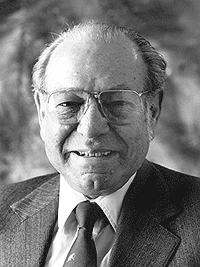Dorian Shainin
| Dorian Shainin | |
|---|---|
 |
|
| Born |
September 26, 1914 San Francisco, California |
| Died | January 7, 2000 (aged 85) Manchester, Connecticut |
| Nationality | American |
| Fields | Reliability engineering, Acceptance sampling |
| Institutions | United Aircraft Corporation, Grumman Aerospace, Shainin LLC |
| Alma mater | Massachusetts Institute of Technology |
| Known for | Red X |
| Influences | Ronald Fisher, John Tukey, Waloddi Weibull |
| Notable awards | The American Society for Quality's Brumbaugh Award (1951), the Edwards Medal (1969), the Eugene L. Grant Award (1981), and the Shewhart Medal (1989) |
Dorian Shainin (September 26, 1914 – January 7, 2000) was an American quality consultant, aeronautics engineer, author, and college professor most notable for his contributions in the fields of industrial problem solving, product reliability, and quality engineering, particularly the creation and development of the "Red X" concept.
Shainin (pronounced SHAY-nin), founder of the technical-problem-solving company Shainin LLC, is responsible for the development of over 20 statistical engineering techniques that have become the core of the "Shainin System" for quality and reliability improvement.
Throughout his life, Dorian Shainin worked to improve the quality and reliability of an array of products, including paper, printing, textiles, rubber, nuclear energy, airplanes, automobiles, cassette decks, space ships, light bulbs and disposable diapers, with clients representing over 200 different industries, ranging from the U.S. Department of Defense, Rolls Royce Ltd. and Exxon to Polaroid, Hewlett-Packard, AT&T and Ford Motor. In total, Shainin advised over 800 companies, 43 of which were among the Fortune 100.
Dorian Shainin was born in San Francisco on September 26, 1914. He grew up in San Francisco, Shanghai, and New York. He attended Erasmus Hall High School in Brooklyn, New York.
After receiving his degree in aeronautical engineering from Massachusetts Institute of Technology (MIT) in 1936, Shainin became a design engineer at the Hamilton Standard Division of United Aircraft Corporation (now United Technologies Corporation).
In 1939 US industry had begun to focus on the war effort, and Shainin became a licensee coordinator responsible for helping new Hamilton Standard licensees solve problems. By the end of the war, Shainin was in charge of quality and reliability at Hamilton Standard, having gained national recognition for his invention of the Hamilton Standard Lot Plot.
Lot Plot refers to a statistical method for acceptance sampling developed by Dorian Shainin in the 1940s. This statistical technique uses the graphical analysis of variable sample data in order to determine if a lot consisting of potentially faulty parts should be accepted or set aside for 100% inspection.
...
Wikipedia
